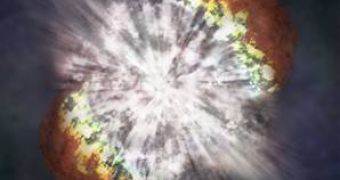Similar to neutron stars, quark stars are believed to be highly compact stellar objects that have been created during the supernova explosion of a relatively massive star. Theoretically, these objects may exist and could be formed only of elementary sub-atomic particles known as quarks, although none has been observed directly so far in the visible universe. Compared to a neutron star, quark stars are slightly more compact. For example, a neutron star could pack about 1.5 solar masses into a nearly perfect sphere only 26 kilometers across, while a quark star could confine roughly the same mass into an object only 19 kilometers across.
Quark stars could also be the source of some of the most luminous supernovae in the universe, say Denis Leahy and Rachid Ouyed from the University of Calgary. Such explosions could release up to 100 times more light than other supernovae, but only occur once for every 1,000 supernova explosions. The mechanism through which so much energy is released is yet unknown, but computer models seem to point towards a quark-nova explosion scenario.
"In theory, when a neutron star converts into a quark star it releases a lot of energy, and it produces something that looks like a supernova explosion in terms of energetics", said Leahy yesterday at the American Astronomical Society. If a star is massive enough, at the end of its life it will create a neutron star that will then collapse into a quark star if the mass of the neutron star is slightly greater than the one necessary for it to remain stable.
"If you make a neutron star massive enough, gravity compresses it so you get a higher and higher density in the center. If you compress matter to a high enough density you'll get quark matter", Leahy said.
The conversion of neutrons into quarks would release massive amounts of energy, enough to create an explosion 100 times more powerful than typical ones. In regular supernova explosions most of the released energy is used to eject the outer layers of the star as the core starts to collapse, while the rest is converted into electromagnetic radiation.
However, during the creation of a quark star from a neutron star, several days after the initial explosion, the released energy would be mostly converted into electromagnetic radiation since the outer layers of the star would have been pushed far enough from the core by the initial blast.
Quarks are elementary sub-atomic particles, part of the fermion family, which, along with leptons, make all the matter in the universe. They are the basic constituents of protons and neutrons (composite particles of three quarks) and pions (consisting of two quarks), short lived particles that decay into a photon and two leptons, an electron and a neutrino.

 14 DAY TRIAL //
14 DAY TRIAL //